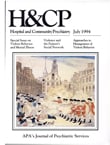Neurobiological Factors in Aggressive Behavior
Abstract
The author's aim was to review literature in the neuro-sciences and psychiatric clinical research reports about biological factors in aggression and the patho-physiological mechanisms that accompany aggression in neuropsychiatric syndromes. Method Studies were located through computer searches of relevant experimental reports and review articles mainly from the last 25 years. Results: Several studies using neuroimaging and neurophysiological and neuro-pathological research techniques have identified lesions in the limbic structures, temporal lobes, and frontal lobes of the brain in abnormally aggressive individuals. Several reports have associated deficiency or dysregulation of serotonin with homicidal, suicidal, and impulsive behavior. However, few studies have focused on polypeptides or second messenger systems, although abnormalities in these systems have been reported in patients with neuropsychiatric syndromes who have shown aggressive behavior. Even fewer studies focus on the correlation of brain structures and metabolic markers. Conclusions: The understanding of aggressive behavior in psychiatric patients is fragmented. Some explanations are speculative and extrapolated to clinical psychiatric syndromes from experimental data on the neurophysiology of cats, rats, and other mammals. identification of biochemical markers that can be used in predicting patients' response to pharmacological interventions may be the next step in developing more rational treatment of violent patients.
Access content
To read the fulltext, please use one of the options below to sign in or purchase access.- Personal login
- Institutional Login
- Sign in via OpenAthens
- Register for access
-
Please login/register if you wish to pair your device and check access availability.
Not a subscriber?
PsychiatryOnline subscription options offer access to the DSM-5 library, books, journals, CME, and patient resources. This all-in-one virtual library provides psychiatrists and mental health professionals with key resources for diagnosis, treatment, research, and professional development.
Need more help? PsychiatryOnline Customer Service may be reached by emailing [email protected] or by calling 800-368-5777 (in the U.S.) or 703-907-7322 (outside the U.S.).



